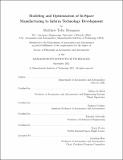Modeling and Optimization of In-Space Manufacturing to Inform Technology Development
Author(s)
Moraguez, Matthew Tyler
DownloadThesis PDF (4.245Mb)
Advisor
de Weck, Olivier
Terms of use
Metadata
Show full item recordAbstract
In-space manufacturing (ISM) has the potential to alter the paradigm of space system design by enabling fabrication of components that are unencumbered by launch-related design constraints. However, the size, weight, and power of manufacturing equipment can easily outweigh the benefits, while the manufacturing equipment capabilities can unnecessarily constrain the set of manufacturable components.
To address this challenge, a methodology is developed to inform ISM technology development by simultaneously considering the design of manufacturing equipment and fabricated components. This methodology relates ISM facility design parameters to overall mission benefit through both manufacturing models, which compute the component properties manufacturable by a given ISM concept, and component models, which compute the mission-level benefit delivered by components with given properties. This methodology has been applied to two case studies of interest. For the case of on-demand spares manufacturing, the results indicate that the maximum possible spares mass savings for a 0.45 m^3 ISM facility is limited to 52% by build volume constraints alone. For the case of ISM solar arrays, the results reveal that a state-of-the-art specific power of 300 W/kg can be realized by an ISM concept that uses thermoplastic pultrusion to produce an 11.6 kg truss structure supporting a 60 kW solar array wing.
The approach presented in this thesis is intended for use by space system designers seeking to incorporate ISM into their mission plans, as well as for ISM technology developers looking to evaluate the impact of their developments on overall mission capabilities. This work is thus positioned to inform the way in which ISM technology development is pursued with the specific purpose of yielding the maximum benefit at the mission level.
Date issued
2021-09Department
Massachusetts Institute of Technology. Department of Aeronautics and AstronauticsPublisher
Massachusetts Institute of Technology